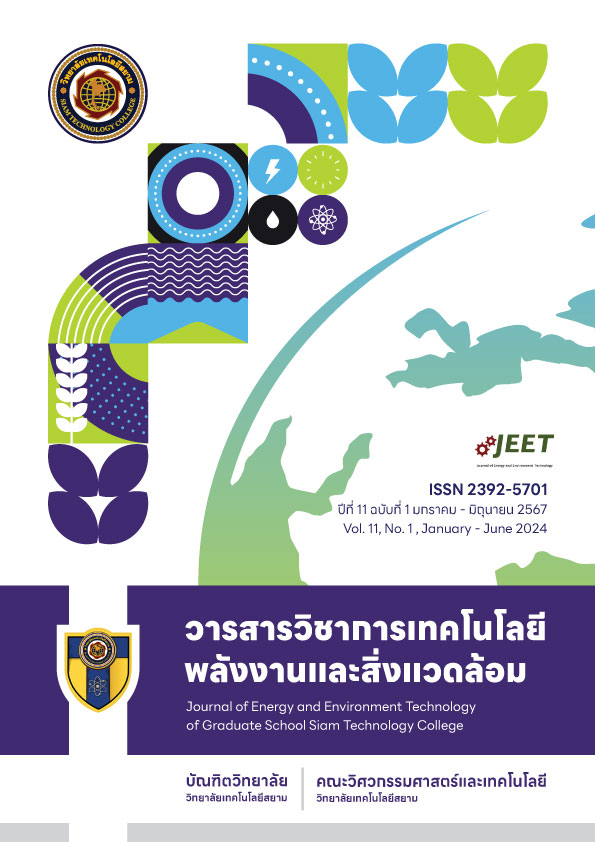APPLICATION OF QUALITY FUNCTION DEPLOYMENT IN THE SAFETY WOODEN PUZZLE DESIGN FOR KIDS
Main Article Content
Abstract
The purpose of this research is to (1) study customer preferences for wooden jigsaw puzzless using house of quality and (2) propose safety guidelines for designing wooden jigsaw puzzless using quality transformation techniques. The study involved 30 parents of children aged 3 months to 12 years. Data was collected through a 5-part questionnaire covering material, design, usefulness, maintenance, and other aspects. Quality Function Deployment (QFD) and House of Quality (HOQ) techniques were used to plan the design and development of wooden jigsaw puzzless. The research revealed six safety aspects ranked by technical importance, including appropriate size (14.54%), durability and lightweight (12.39%), cleanliness and absence of foreign substances (12.22%), sturdy packaging (12.17%), standard paint color (7.79%), and smooth surface (6.52%). The design guidelines summarized that wooden jigsaw puzzless should be larger than 3.2 cm and longer than 6 cm for children over 3 years old, made of strong and lightweight wood, and packaged in sturdy boxes. The paint should be durable, free from toxic substances, and the surface should be smooth.
Article Details

This work is licensed under a Creative Commons Attribution-NonCommercial-NoDerivatives 4.0 International License.
เนื้อหาและข่อมูลในบทความที่ลงตีพิมพ์ในวารสารวิชาการ เทคโนโลยี พลังงาน และสิ่งแวดล้อม บัณฑิตวิทยาลัย วิทยาลัยเทคโนโลยีสยาม ถือเป็นข้อคิดเห็นและความรับผิดชอบของผู้เขียนบทความโดยตรง ซึ่งกองบรรณาธิการวารสารไม่จำเป็นต้องเห็นด้วย หรือว่าร่วมรับผิดชอบใด ๆ
บทความ ข้อมูล เนื้อหา รูปภาพ ฯลฯ ที่ได้รับการตีพิมพ์ในวารสารวิชาการ เทคโนโลยี พลังงาน และสิ่งแวดล้อม บัณฑิตวิทยาลัย วิทยาลัยเทคโนโลยีสยาม ถือเป็นลิขสิทธิ์ของวารสารวิชาการ เทคโนโลยี พลังงาน และสิ่งแวดล้อม บัณฑิตวิทยาลัย วิทยาลัยเทคโนโลยีสยาม หากบุคคล หรือหน่วยงานใดต้องการนำทั้งหมด หรือส่วนหนึ่งส่วนใดไปเผยแพร่ต่อ หรือเพื่อกระทำการใด ๆ จะต้องได้รับอนุญาต เป็นลายลักษณ์อักษรจากวารสารวิชาการ เทคโนโลยี พลังงาน และสิ่งแวดล้อม บัณฑิตวิทยาลัย วิทยาลัยเทคโนโลยีสยาม เท่านั้น
References
Department of Disease Control (Thailand). [Internet] 2023 [cited 2024 January]. Available from: https://ddc.moph.go.th/uploads/publish/1037220200813043.
Srithorn, J., Kongkanjana, K., Sathaporn P. (2023). The Study of Children’s Toy Safety Management in Nakhon Ratchasima Province. Proceeding IE Network Conference 2023 (pp. 402-408).
Rawangwong S., Homkhiew C., Sani S., Boonchouytan W., Kamnerdwamand T., Tehyo M. (2020). Design and Development of Furniture Products Made from Oil Palm Trunk Using Quality Function Deployment Technique: A Case Study of Oil Palm Wooden Furniture Manufacturer, Satun Province. Princess of Naradhiwas University Journal, Vol.2, 199-220.
สมศักดิ์ สุวรรณมิตร และ ดำรงค์ ทวีแสงสกุลไทย. (2553). การปรับปรุงคุณภาพของผลิตภัณฑ์รถยนต์บรรทุก 2 ตัน โดยใช้เทคนิค QFD. วารสารวิจัย มข. ปีที่ 15, เล่มที่ 7.
มณฑลี ศาสนนันทน์ และ ชินะ รอดศิริ. (2556). การศึกษาแนวทางปรับปรุงงานบริการโดยใช้เทคนิคการกระจายหน้าที่เชิงคุณภาพด้านสิ่งแวดล้อม : กรณีศึกษาอาคารผู้โดยสารท่าอากาศยานสุวรรณภูมิ. วารสารวิทยาศาสตร์และเทคโนโลยี, ปีที่ 21, เล่มที่ 1.
Thongpang P., Rattanasiriwatt W., Prachprayoon P., Tungku G. & Sornsut C. Quality Function Deployment (QFD Designing an Egg Incubator Using Quality Function Deployment Technique. IENJ. 2023. 9(2): 14-28.
Akao, Y. (2012). The method for motivation by Quality Function Deployment (QFD). Nang Yan Business Journal, 1(1), 1-9.
Sivasankaran P. (2021) Quality concepts in Industrial systems using QFD (Quality Function Deployment) –Survey. SSRG International Journal of Industrial Engineering. Vol.1, 2021, 7-13.
Sinthavalai R and Ruengrong S. An Application of House of Quality (HOQ) for Designing Rice Product as a Souvenir. Naresuan University Journal: Science and Technology. 2018. Vol.3, 36-51.
Rovinelli, R.J. and Hambleton, R.K. (1997). On the use of content specialist in the assessment of criterion-referenced test ítem validity. Dutch Journal of Educational Research, 2, 49-60.
Department of Health (Thailand). (2023). [Internet] 2013 [cited 2024 January]. Available from:https://multimedia.anamai.moph.go.th/infographics/info457_toy/


